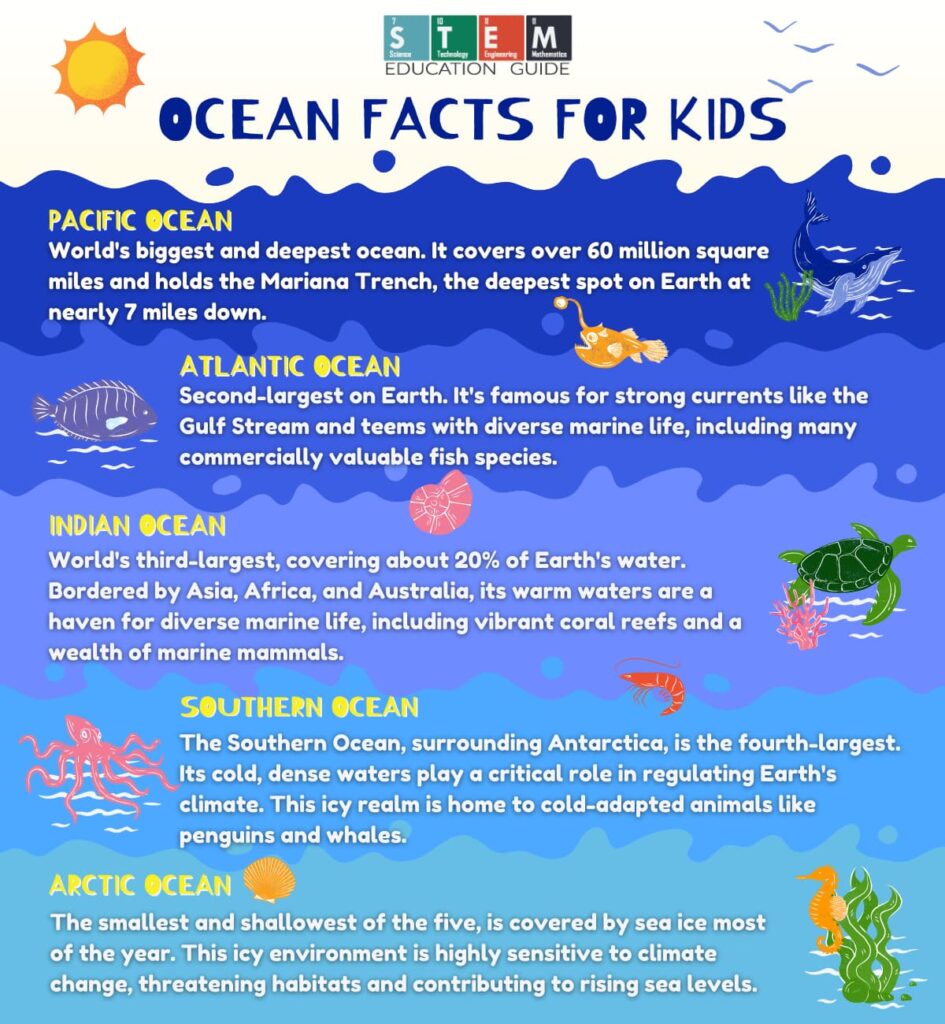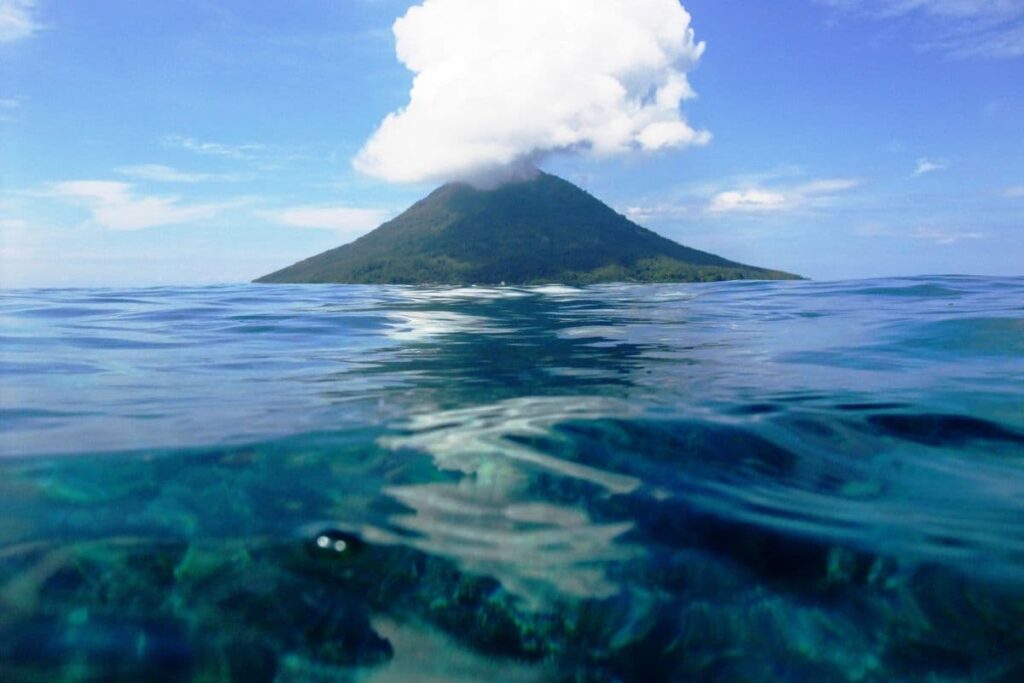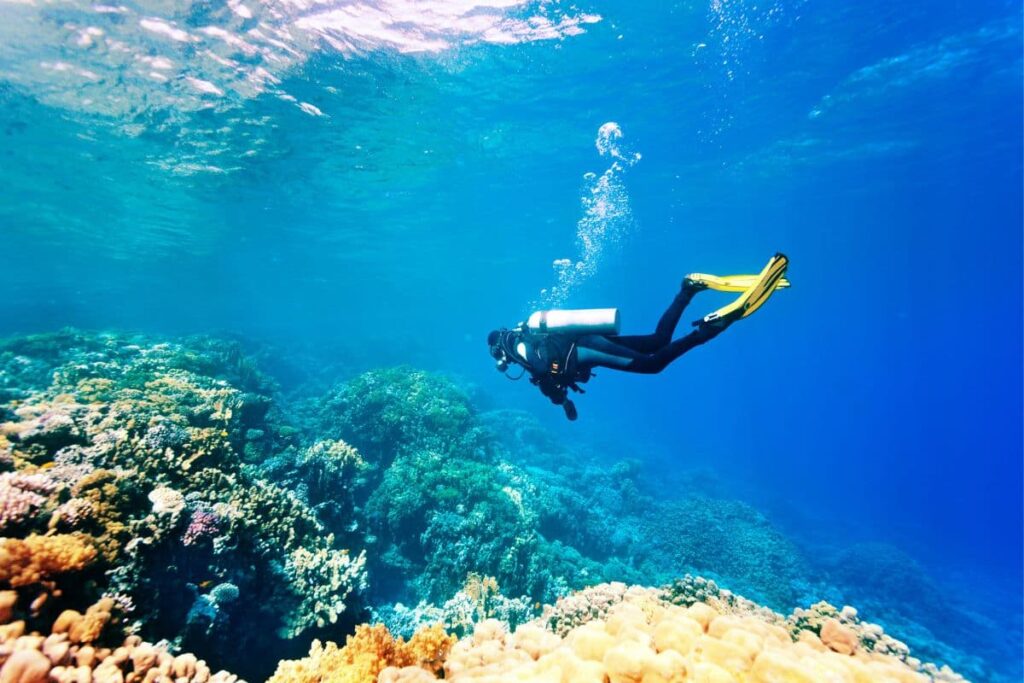If you’re looking for intresting facts about the ocean then you’ve come to the right place. These ocean facts are fun for everyone but I kept kids in mind while making this. I really wanted to “blow their minds” when they hear some of these.
So, let’s get into the most intresting ocean facts for kids!
Table of Contents
The World’s Oceans

Did you know that the Pacific Ocean is larger than all the Earth’s land combined?
Oceans, covering over 70% of Earth’s surface, are full of life and provide crucial ecosystems.
Our planet is home to five oceans, each with its unique characteristics and marine life. They play crucial roles in Earth’s climate and host an incredible diversity of creatures.

- Size and Coverage: Earth’s oceans—Pacific, Atlantic, Indian, Southern, and Arctic—cover nearly 71% of its surface.
- Deep Underwater Landscapes: Features like the continental shelves, ocean basins, and the deep trenches, such as the Mariana Trench, create an undersea terrain that’s both dramatic and mysterious.
- Crucial for Life: The intriguing creatures in the ocean, many of whom are experts in camouflage, are just one aspect of its role in sustaining life. Oceans are also home to phytoplankton that produce about half of the world’s oxygen.
Let’s analyze and check out each one!
Pacific Ocean
| Feature | Highlights |
|---|---|
| Size | Largest and deepest of Earth’s oceanic divisions |
| Surface Area | More than 60 million square miles |
| Key Features | Contains the Mariana Trench, the deepest known point in the Earth’s oceans, at approximately 11 kilometers below the surface |
Atlantic Ocean
| Feature | Highlights |
|---|---|
| Size | Earth’s second-largest ocean |
| Currents | Known for powerful currents like the Gulf Stream |
| Ecosystem | Supports a rich ecosystem with a variety of life, including economically important fish species |
Indian Ocean
| Feature | Highlights |
|---|---|
| Size | Ranked third in size, covers about 20% of the Earth’s water surface |
| Location | Bounded by Asia, Africa, and Australia |
| Marine Life | Warmer ocean sustaining diverse biological species, significant coral reefs, and marine mammals |
Southern Ocean
| Feature | Highlights |
|---|---|
| Key Facts | Fourth-largest ocean, surrounding Antarctica |
| Climate Impact | Pivotal in regulating Earth’s climate via its cold, dense water masses |
| Wildlife | Home to species adapted to the cold, such as penguins and whales |
Arctic Ocean
| Feature | Highlights |
|---|---|
| Surface Area | Smallest and shallowest of the five oceans |
| Ice Coverage | Mostly covered by sea ice throughout the year |
| Environmental Concerns | Sensitive to climate change, impacting habitats and global sea levels |
Ocean Life

Marine Animals
The ocean is teeming with life, from the smallest plankton to the largest whales. Over 200,000 identified species thrive underwater, and many more remain undiscovered.
Dolphins are known for their intelligence and playful behavior, while whales traverse the ocean as gentle giants. The ocean depths harbor remarkable creatures like the squid, along with a variety of fish species.
- Jellyfish: Often found floating or pulsating through the water.
- Squid: Notable for their rapid movements and impressive camouflage capabilities.
That is why biodiversity is essential for the ecosystem as each species plays a vital role in maintaining the health of the ocean.
Plant Life
The ocean is not just home to animals but also a wide variety of plants and algae, which are fundamental to the oceanic food chain.
The most significant are phytoplankton, tiny drifting plants that produce approximately 50% of the world’s oxygen.
- Seaweeds: Varying from small species to giant kelp forests.
- Coral Reefs: Often referred to as the “rainforests of the sea” due to their rich biodiversity.
Ocean Habitats
Ocean habitats range from the sunlit surface waters to the mysterious depths of the ocean floor. The shallow continental shelf areas support a rich diversity of life and give way to deep basins and trenches.
The flat plains on the bottom are known as the abyssal plains.
- Coral Reefs: Provide shelter for a multitude of marine species.
- The Ocean Floor: Home to extraordinary creatures, adapted to life in complete darkness and extreme pressure.
Preserving Ocean Life
Pollution, specifically ocean pollution and plastic pollution, poses a significant threat to marine life. Conservation efforts are critical to protect species and their habitats.
STEM Education Guide Pro-Tip: To actively participate in ocean conservation, consider reducing your use of single-use plastics and supporting marine protected areas.
And don’t forget about conservation strategies, including establishing marine protected areas and restoring damaged ecosystems.
Are you looking for a fun project for your class or just something to keep the kids busy? Well, check out these Exciting Projects for Teaching Kids About Electric Circuits!
Ocean Geography and Features

Unique Ocean Landforms
1. Continental Shelves
These are underwater landmasses that extend from a continent, making up the edges of the underwater world where the ocean is relatively shallow compared to the open ocean areas.
2. Ocean Basins
Beyond the continental shelves lie the ocean basins, which are deeper parts that encompass flat plains, underwater volcanoes, and mountain ranges.
3. Mariana Trench
Can you imagine how deep the Mariana Trench is compared to the tallest building you know?
The Mariana Trench is the deepest known, plunging to depths of 36,070 feet (10,994 meters). It exemplifies one of the many trenches and canyons that form as tectonic plates move and create remarkable features on the ocean floor.
4. Volcanoes & Mountains
Many undersea mountains are volcanoes. Some are dormant, while others are active, contributing to the dynamic landscape underwater.
5. Trenches
Formed by plate tectonics, trenches are some of the deepest points in the ocean. These deep-sea canyons are critical to understanding the geological and biological processes of the ocean floor.
The Deep Sea
Below the sunlit ocean surface, the deep sea is a region of high pressure, extreme darkness, and cold.
The average depth of the world’s oceans is around 12,200 feet, but this is only a number.
In the depths, marine life must adapt to survive without light, and the pressure is so intense that it could crush most human-made objects.
The ocean depth can vary greatly, with some areas far deeper than anyone has ever ventured. The environment at these depths is harsh and largely unexplored, making it one of the most intriguing aspects of ocean geography.
- The Challenger Deep: Located within the Mariana Trench, it represents the known deepest point of the ocean.
- Pressure & Darkness: The pressure increases by one atmosphere for every 33 feet of water depth, and below about 1,000 feet, sunlight can no longer penetrate, enveloping the area in darkness.
Ocean Environment
Ocean Water
The ocean’s water is more than just plain H2O! It’s a cocktail of sodium chloride, which is common table salt, and a variety of other minerals. This mix gives the ocean its salty character.
The average salinity is about 35 parts per thousand, mostly comprised of sodium and chloride ions. Sunlight penetrates the top layer of the ocean, affecting temperature and providing energy for photosynthetic organisms.
- Salinity: ~35 ppt (parts per thousand)
- Main components: Sodium, Chloride
Climate Influence
The ocean is fundamental to Earth’s climate system, absorbing solar heat and redistributing it worldwide via warm and cold currents, which in turn helps stabilize global weather patterns and temperatures.
| Climate Regulation Mechanisms | Role in Climate System |
|---|---|
| Heat distribution via currents | Distributes solar heat globally, stabilizing temperatures |
| Tides and winds | Contribute to the regulation of weather patterns and help maintain the climate balance |
As a matter of fact, each wave not only carries the rhythmic pulse of the sea but also serves as a conduit for transferring vital solar energy, harmonizing the global climate with every crest and trough.
Ecosystem Dynamics
Food chains in the ocean start with plankton, microscopic plants which are the ocean’s primary producers. Larger organisms, like zooplankton, feed on these tiny plants. This process continues to the apex predators.
Ocean currents, tides, and winds influence the distribution of food and movement of creatures, sustaining diverse marine life.
Human and Ocean Interactions

Ocean Exploration
Oceanographers and National Geographic expeditions have mapped out the seafloor and uncovered remarkable features, such as the Titanic wreck.
The advent of scuba diving has opened up new chances for research and recreation, allowing for personal exploration of underwater worlds.
Ocean Resources
Seafood serves as an important source of food for coastal communities and the global population. Industrially, the ocean is tapped for minerals and salt used to produce table salt. Also, it’s a contender for renewable energy development, with efforts to harness waves and tides.
| Resource Type | Examples of Use |
|---|---|
| Biological | Food, medicine |
| Mineral | Salt production, jewelry |
| Energy | Wind farms, tidal power |
Environmental Impact
Pollution not only harms wildlife but also compromises the very resources people rely on, underscoring the need for global collaboration in environmental protection efforts. Therefore, conservation actions are vital to protect the ocean’s health.
STEM Education Guide Pro-Tip: Engage in practices that minimize environmental impact, such as participating in responsible tourism and supporting sustainable seafood choices
Industries, governments, and individuals are increasingly called upon to reduce their environmental impact and practice sustainable practices.
- They must implement pollution controls and support ocean conservation.
- They are urged to take action to preserve their marine environment.
Fascinating Ocean Trivia
Record-Breaking Facts
Deepest Point: The Mariana Trench is the deepest part of the world ocean, plunging to nearly 7 miles below the surface.
Longest Mountain Range: Lurking underwater, the Mid-Atlantic Ridge is the world’s longest mountain range, stretching over an impressive 40,000 miles.
Uncharted Depths: Despite modern technology, over 80% of the ocean remains unexplored and full of marine mysteries.
Teeming Biodiversity: Home to a spectacular array of life, the ocean’s biodiversity is immense, with countless species yet to be discovered.
Maritime Mythology: Oceans have inspired numerous myths, from the story of Atlantis to Poseidon’s wrath, weaving a rich tapestry of lore.
Influence in Art and Literature: The vast blue seas have fired up centuries of creativity, reflecting their essence in art, history, and literature across the globe.
Ending Thoughts – Raise Awareness About Ocean Conservation
It is clear that the importance of the ocean can be felt worldwide. They are not just waters that separate continents but a critical part of the Earth’s ecosystem.
As kids learn more about the ocean, they discover how important it is for supporting sea creatures and life on land. This knowledge helps everyone understand why we need to protect our oceans for future generations.









